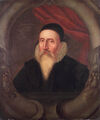Template:Selected anniversaries/February 25: Difference between revisions
No edit summary |
No edit summary |
||
| (37 intermediate revisions by the same user not shown) | |||
| Line 1: | Line 1: | ||
<gallery> | <gallery> | ||
|| | File:John Dee.jpg|link=John Dee (nonfiction)|1598: [[John Dee (nonfiction)|John Dee]] demonstrates the solar eclipse by viewing an image through a pinhole. Two versions from Ashmole and Aubrey give different details of who was present. Dee's Diary only contains the notation, "the eclips. A clowdy day, but great darkness about 9 1/2 maine". | ||
File: | File:Friedrich Reinitzer.jpg|link=Friedrich Reinitzer (nonfiction)|1857: Botanist and chemist [[Friedrich Reinitzer (nonfiction)|Friedrich Reinitzer]] born. In late 1880s, experimenting with cholesteryl benzoate, Reinitzer discovered the properties of what would later be called liquid crystals; although the discovery attracted attention, interest soon faded as no practical uses were found at the time. | ||
|| | File:Theodor Svedberg.jpg|link=Theodor Svedberg (nonfiction)|1971: Chemist and academic [[Theodor Svedberg (nonfiction)|Theodor Svedberg]] dies. He was awarded the 1926 Nobel Prize in Chemistry for his pioneering use of analytical ultracentrifugation to distinguish pure proteins from one another. | ||
|| | File:Hugo Steinhaus.jpg|link=Hugo Steinhaus (nonfiction)|1972: Mathematician and academic [[Hugo Steinhaus (nonfiction)|Hugo Steinhaus]] dies. He discovered mathematician Stefan Banach, with whom he made notable contributions to functional analysis, including the Banach–Steinhaus theorem. | ||
File: | File:Glenn Seaborg.jpg|link=Glenn T. Seaborg (nonfiction)|1999: Chemist [[Glenn T. Seaborg (nonfiction)|Glenn T. Seaborg]] dies. He shared the 1951 Nobel Prize in Chemistry for the synthesis, discovery, and investigation of transuranium elements. | ||
</gallery> | </gallery> | ||
Latest revision as of 06:14, 25 February 2022
1598: John Dee demonstrates the solar eclipse by viewing an image through a pinhole. Two versions from Ashmole and Aubrey give different details of who was present. Dee's Diary only contains the notation, "the eclips. A clowdy day, but great darkness about 9 1/2 maine".
1857: Botanist and chemist Friedrich Reinitzer born. In late 1880s, experimenting with cholesteryl benzoate, Reinitzer discovered the properties of what would later be called liquid crystals; although the discovery attracted attention, interest soon faded as no practical uses were found at the time.
1971: Chemist and academic Theodor Svedberg dies. He was awarded the 1926 Nobel Prize in Chemistry for his pioneering use of analytical ultracentrifugation to distinguish pure proteins from one another.
1972: Mathematician and academic Hugo Steinhaus dies. He discovered mathematician Stefan Banach, with whom he made notable contributions to functional analysis, including the Banach–Steinhaus theorem.
1999: Chemist Glenn T. Seaborg dies. He shared the 1951 Nobel Prize in Chemistry for the synthesis, discovery, and investigation of transuranium elements.





